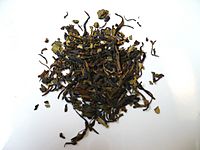Nilgiri tea facts for kids
 |
|
| Type: | Black tea |
|
|
|
| Other names: | Blue Mountain tea |
| Origin: | Nilgiris, Tamil Nadu, India |
|
|
|
| Quick description: | Brisk and fragrant |
|
|
|
| Temperature: | 90 °C (194 °F) to 95 °C (203 °F) |
| Time: | 3 to 4 minutes |
Nilgiri tea is a special kind of tea that comes from the Nilgiris district in Tamil Nadu, India. It's made from the leaves of the Camellia sinensis plant. These leaves are mostly processed to make black tea. However, some places also make green, white, and oolong teas.
People often describe Nilgiri tea as fresh, fragrant, and full of flavour. It's used a lot in tea blends, and it's also great for making iced tea and instant tea. The tea plant variety used here, Camellia sinensis var. sinensis, was brought to the Nilgiri Mountains by the British in 1835. The area's rich soil and unique weather help this tea grow very well.
Contents
History of Nilgiri Tea
Early Plantings (1835-1900s)
The first Camellia sinensis tea plants were put in the ground in the Nilgiri area in 1835. The British used this area as a cool hill station (a place to escape the heat). They wanted to grow tea outside of China, so they sent tea seeds to various spots in southern India for testing.
A botanist named George Samuel Perrottet planted these seeds in the governor's garden. Even though they weren't perfectly cared for, they grew. Commercial tea production officially started in 1862. By 1904, over 3,200 hectares (about 7,900 acres) of land were used for tea.
Many early tea farms struggled at first. But with help from Chinese tea-makers, the industry began to grow. European farmers later formed groups like the Nilgiri Planters' Association to help their businesses.
Growth and Changes (1947-Present)
After Indian independence in 1947, British owners started selling their tea gardens to Indian owners. In 1953, the Tea Act placed the tea industry under the Tea Board of India. A tea auction was set up in Coonoor in 1963.
From the 1970s to the 1990s, countries in the Soviet bloc bought most of the Nilgiri tea. To meet their demand for cheaper, mass-produced teas, processing methods changed. More factories were built, and small farmers joined together in groups like Indcoserve.
Tea production increased in the 1970s. This was partly because many Indian Tamils of Sri Lanka came to the region. The Tamil Nadu Tea Plantation Corporation was created by the government to help these people by providing jobs in tea gardens.
By the 1980s, the Soviet economies began to weaken. The Nilgiri Planters' Association encouraged tea estates and small growers to improve their tea. They started growing new types of tea plants and making different kinds of tea, like orthodox-rolled teas and white teas. They also began selling teas from single estates. In 2008, Nilgiri tea received a special geographical indication status. This means it's officially recognized as unique to its region.
Where Nilgiri Tea Grows
Geography and Climate
Nilgiri tea is grown and processed only in the Nilgiris district of Tamil Nadu. This district is mostly within the Western Ghats mountain range. The tea growing areas are high up, between 1,000 and 2,500 meters (about 3,300 to 8,200 feet) above sea level.
The region gets two monsoon seasons each year. The Southwest Monsoon brings rain from June to September. Then, the Northeast Monsoon arrives from October to November. These alternating periods of fog and sunshine, along with the special soil on the hillsides, create perfect conditions for the Camellia sinensis var. sinensis tea plant to grow.
Cultivation and Processing
Tea in the Nilgiri region is grown on large company farms, many small family farms, and government-owned plantations. Small farms are usually less than 1 hectare (about 2.5 acres) in size.
Tea leaves can be picked almost all year round, about every 10 days. This means each plant is picked around 32 times a year! The sinensis tea plant needs a short rest period. In Nilgiris, this happens in December and January when it's colder. The first leaves picked after this cold period are called "frost tea." They are very flavourful because the plant makes more protective compounds in the cold weather.
Large tea estates have their own factories to dry, roll, and sort the tea leaves. There are also many independent factories that buy green leaves from small farms. These factories mostly make black tea. However, some also produce small amounts of special white, green, and oolong teas. Most black tea made here uses the crush, tear, curl (CTC) method. But since the 2000s, more orthodox (rolled) teas are also being made.
Flavour and Uses
Taste and Blends
Nilgiri tea is known for its fresh and lively flavour. This special taste comes from the unique weather conditions where it grows. People describe Nilgiri tea as light but full-bodied. It often has fruity notes, like citrus, and floral hints.
Its orthodox tea is often compared to Ceylon teas because they grow in similar conditions. Because of its light but fragrant taste, Nilgiri tea is great for mixing with other teas. You can find it in many bagged tea brands and blended with Assam tea in masala chai.
Perfect for Iced Tea
Nilgiri tea is especially good for making iced tea. This is because it stays clear and doesn't get cloudy when it cools down. Other black teas often become cloudy when they get cold. Big global brands, like Nestea, use Nilgiri tea in their iced tea products that are made with real tea.



